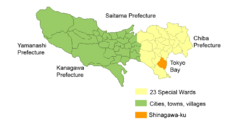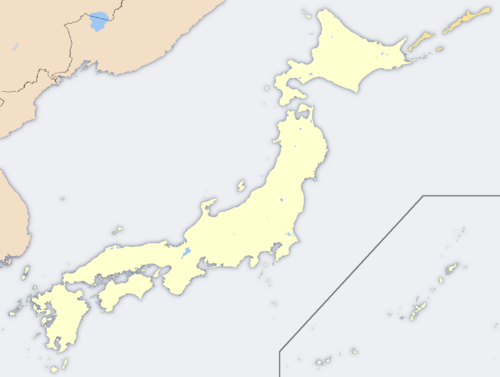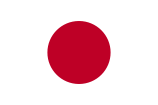Shinagawa, Tokyo
 Shinagawa's location in Tokyo, Japan. |
|
 Shinagawa's location in Japan. |
|
| Location | |
| Country | Japan |
| Region | Kantō |
| Prefecture | Tokyo |
| Physical characteristics | |
| Area | 22.77 km2 (8.79 sq mi) |
| Population (as of 2008) | |
| Total | 344,461 |
| Density | 15,740 /km² (40,766 /sq mi) |
| Location | |
| Symbols | |
 Flag |
|
| Shinagawa Government Office | |
| Official website: Shinagawa (Japanese) | |
Shinagawa (品川区 Shinagawa-ku?) is one of the 23 special wards of Tokyo, Japan. In English, it calls itself Shinagawa City. The ward is home to nine embassies.
As of 2008, the ward has an estimated population of 344,461 and a density of 15740 persons per km². The total area is 22.72 km².
Contents |
Geography

Shinagawa includes natural uplands and lowlands, as well as reclaimed land. The uplands are the eastern end of the Musashino hills. They include Shiba Shiroganedai north of the Meguro River, Megurodai between the Meguro and Tachiai Rivers, and Ebaradai south of the Tachiai River.
The ward lies on Tokyo Bay. Its neighbors on land are all special wards of Tokyo: Kōtō to the east, Minato to the north, Meguro to the west, and Ōta to the south.
The ward consists of five districts:
- the Shinagawa district, including the former Shinagawa post on the Tōkaidō
- the Ōsaki district, formerly a town, stretching from Ōsaki Station to Gotanda and Meguro Stations
- the Ebara district, formerly a town of that name
- the Ōi district, previously the town
- the Yashio district, consisting of reclaimed land
History
Most of Tokyo east of the Imperial Palace is reclaimed land. A large portion of reclamation happened during the Edo period. The ward was founded on March 15, 1947, through the administrative amalgamation of the former Ebara Ward with the former Shinagawa Ward. Both Ebara Ward and Shinagawa Ward had been created in 1932, with the outward expansion of the municipal boundaries of the Tokyo City following the 1923 Great Kantō Earthquake.
In the Edo period, Shinagawa was the first post town a traveler would reach after setting out from Nihombashi on the Tōkaidō highway from Edo to Kyoto. The post-town function is retained today with several large hotels near the train station offering 6,000 hotel rooms, the largest concentration in the city. The Tokugawa shogunate maintained the Suzugamori execution grounds in Shinagawa. The Tōkaidō Shinkansen began serving Shinagawa Station from 2003, and the nearby Shinagawa Intercity office complex will be served by a new subway station in a few years' time.
Politics and government
Shinagawa is run by a city assembly of 40 elected members. The mayor as of 2007 is Takeshi Hamano, an independent. Liberal Democratic Party together with New Komeito currently forms government.
- Shinagawa local election, 2007
- Shinagawa mayoral election, 2006
Places
- The Institute for Research in Human Happiness
- National Institute of Japanese Literature
- Shinagawa Shrine
- Suzugamori Execution Grounds (Edo period)
- TV Tokyo Tennozu Studios
Education
Universities
- Hoshi University
- Rissho University
- Seisen University
- Showa University
- Sugino Women's University
Special colleges
Tokyo Metropolitan Government Board of Education operates two special colleges in Shinagawa:
- Tokyo Metropolitan College of Technology [1]
- Tokyo Metropolitan College of Industrial Technology [2]
Primary and secondary
Public elementary and junior high schools are operated by the Shinagawa Ward Board of Education. Public high schools are operated by the Tokyo Metropolitan Government Board of Education.
Public high schools in Shinagawa include:
Transportation
-
For more details on this topic, see Transportation in Greater Tokyo .
Important train stations


Shinagawa Station in neighboring Minato also serves Shinagawa, and is a stop on the high-speed Tōkaidō Shinkansen line.
- Gotanda Station
- Meguro Station
- Ōsaki Station
- Ōimachi Station
Rail
- East Japan Railway Company (JR East)
- Yamanote Line: Ōsaki, Gotanda, Meguro Stations
- Keihin-Tōhoku Line: Ōimachi Station
- Saikyō Line: Ōsaki Station
- Tōkaidō Main Line: does not stop in Shinagawa
- Yokosuka Line: Nishi-Ōi Station
- Shōnan-Shinjuku Line: Ōsaki, Nishi-Ōi Stations
- Tokyu Corporation (Tōkyū)
- Tōkyū Meguro Line: Meguro, Fudo-mae, Musashi-Koyama, Nishi-Koyama Stations
- Tōkyū Ōimachi Line: Shimo-Shinmei, Togoshi Koen, Nakanobe, Ebaramachi, Hatanodai Stations
- Tōkyū Ikegami Line: Gotanda, Ōsaki-Hirokoji, Togoshi Ginza, Ebara Nakanobu, Hatanodai Stations
- Tokyo Waterfront Area Rapid Transit: Tennōzu Isle, Shinagawa Seaside, Ōimachi, Ōsaki Stations
- Tokyo Monorail: Tenn-zu Isle, Ōi Keibajō-mae Stations
- Keihin Electric Express Railway (Keikyū)
- Main Line: Kita-Shinagawa, Shin-Bamba, Aomono Yokocho, Samezu, Tachiaikawa, Ōmori-Kaigan Stations
- Tokyo Metro
- Namboku Line: Meguro Station
- Tokyo Metropolitan Bureau of Transportation
- Mita Line: Meguro Station
- Asakusa Line: Gotanda, Togoshi, Nakanobu Stations
Road
- Shuto Expressway
- No. 1 Haneda Route (Edobashi JCT - Iriya)
- No.2 Meguro Route (Ichinohashi JCT - Togoshi)
- Bayshore Route (Kawasaki-Ukishima JCT - Koya)
- National highways of Japan
- Route 1
- Route 15
- Route 357
Shinagawa is also home to the main motor vehicle registration facility for central Tokyo (located east of Samezu Station). As a result, many license plates in Tokyo are labeled with the name "Shinagawa."
Companies
- Adobe Systems (Japan headquarters)
- Imagica: cinema postproduction
- Isuzu: automobile manufacturer
- Japan Airlines
- JTB Corporation: major travel agency
- Namco Bandai Games: video game company (located in the former Panasonic building)
- Pola Cosmetics: cosmetics maker
- Siemens Japan
- Sony (recently, the headquarters moved to Minato, Tokyo)
- Philips
- Acura (Honda is based in Minato, Tokyo)
- NSK Ltd. (Bearings maker)
People
- Dokumamushi Sandayu: actor
- Empress Michiko of Japan
- Renji Ishibashi: actor
- Akira Kurosawa: director
- Hiroyuki Sanada: actor
- Junko Yaginuma: Olympic figure skater
- Shinobu Otake: actress
- Maiko Yamada: actress
- Hiroyuki Sanada: actor
Events
The Kariya Kiyoshi Abduction took place in Shinagawa. On February 28, 1995, members of Aum Shinrikyo abducted Kariya, a public employee, and took him to their facility in Kamikuishiki, Yamanashi, where one of their members, Hayashi Ikuo, gave him an overdose of sodium thiopental of which he died. They incinerated his body and dumped his ashes in Lake Kawaguchi.
Sister cities

 Portland, Maine, United States
Portland, Maine, United States Geneva, Switzerland
Geneva, Switzerland Auckland, New Zealand
Auckland, New Zealand Harbin, People's Republic of China
Harbin, People's Republic of China Hayakawa, Japan
Hayakawa, Japan
See also
References
External links
- Shinagawa City official website in English
- Shinagawa City (Japanese)
- Shinagawa on Wikitravel
|
|||||||||||||||||